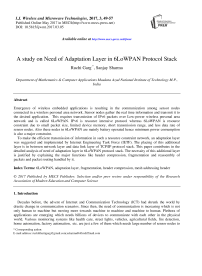A study on Need of Adaptation Layer in 6LoWPAN Protocol Stack
Автор: Ruchi Garg, Sanjay Sharma
Журнал: International Journal of Wireless and Microwave Technologies(IJWMT) @ijwmt
Статья в выпуске: 3 Vol.7, 2017 года.
Бесплатный доступ
Emergence of wireless embedded applications is resulting in the communication among sensor nodes connected in a wireless personal area network. Sensor nodes gather the real time information and transmit it to the desired application. This requires transmission of IPv6 packets over Low-power wireless personal area network and is called 6LoWPAN. IPv6 is resource intensive protocol whereas 6LoWPAN is resource constraint due to small packet size, limited device memory, short transmission range, and less data rate of sensor nodes. Also these nodes in 6LoWPAN are mainly battery operated hence minimum power consumption is also a major constraint. To make the efficient transmission of information in such a resource constraint network, an adaptation layer was suggested and implemented by Internet Engineering Task Force (IETF). The placing of this additional layer is in between network layer and data link layer of TCP/IP protocol stack. This paper contributes in the detailed analysis of need of adaptation layer in 6LoWPAN protocol stack. The necessity of this additional layer is justified by explaining the major functions like header compression, fragmentation and reassembly of packets and packet routing handled by it.
6LoWPAN, adaptation layer, fragmentation, header compression, mesh addressing header
Короткий адрес: https://sciup.org/15012986
IDR: 15012986
Список литературы A study on Need of Adaptation Layer in 6LoWPAN Protocol Stack
- R. Hinden and S. Deering. Internet Protocol Version 6 (IPv6) Addressing Architecture. RFC 3513. [Online]. Available: http://tools.ietf.org/ html/ rfc3513
- B. A. Forouzan, “Network Layer: Internet Protocol”, in Data Communication & Networking,” 4th ed. New York: McGraw-Hill, 2007, ch. 20, pp. 582-597.
- Z. Shelby and C. Bormann, “Introduction,” in 6LoWPAN: The Wireless Embedded Internet, 1 ed. United Kingdom: Wiley, 2009, pp. 3-11.
- N. Kushalnagar, G. Montenegro and C. Schumacher, “IPv6 over Low-Power Wireless Personal Area Networks (6LoWPANs): Overview, Assumptions, Problem Statement, and Goals,” RFC 4919, IETF network working group, Aug. 2007.
- G. Montenegro, N. Kushalnagar, J. Hui and D. Culler,”Transmission of IPv6 Packets over IEEE 802.15.4 Networks,” RFC 4944, IETF network working group, Sep.2007.
- Jonathan W. Hui and D. Culler,“Extending IP to Low-Power, Wireless Personal Area Networks,” IEEE Internet Comput. vol. 12, Issue 4, pp. 37-45, July-Aug. 2008.
- N. H. A. Ismail, R. Hassan and K. W. M. Ghazali, “A Study on protocol stack in 6LoWPAN model,” JATIT, vol. 41 issue 2, pp. 220-229, 2012.
- Jonas Olsson,” 6LoWPAN Demystified,” Texas Instruments, October 2014.
- A. Ludovici, A. Calveras and J. Casademont, “Forwarding Techniques for IP Fragmented Packets in a real 6LoWPAN network,” Sensors, pp. 992-1008, 2011.
- J. Hui, D. Culler and S. Chakrabarti, “6LoWPAN: Incorporating IEEE 802.15.4 into the IP architecture”, Internet Protocol for Smart Objects (IPSO) Alliance, White paper # 3, Jan 2009.
- A. Ludovici, A. Calveras, M. Catalan, C. Gómez, and J. Paradells, “Implementation and Evaluation of the Enhanced Header Compression (IPHC) for 6LoWPAN,” EUNICE 2009, LNCS 5733, pp. 168–177, 2009. © Springer-Verlag Berlin Heidelberg 2009.
- J. Hui and D. Culler, “Stateless IPv6 Header Compression for Globally Routable Packets in 6LoWPAN Sub networks,” draft-hui-6lowpan-hc1g-00, June 2007.
- J. Hui and P. Thumbert, “Compression format for IPv6 datagrams over IEEE 802.15.4 based networks,” RFC 6282, IETF network working group, Sep. 2011.
- R. Garg and S. Sharma,”Comparative Study on Techniques of IPv6 Header Compression in 6LoWPAN” Proc. of the Intl. Conference on Advances in Information Processing and Communication Technology - IPCT 2016, Italy, pp. 34-38, ISBN: 978-1-63248-099-6 doi: 10.15224/ 978-1-63248-099-6-33
- W. Huiqin and D. Yongqiang, “An Improved Header Compression Scheme for 6LoWPAN Networks,” in Ninth International Conference on Grid and Cloud Computing, © 2010 IEEE DOI 10.1109/GCC.2010.74
- A. H. Chowdhury , M. Ikram, H. S. Cha, H. R., S.M. Saif Shams, K.H. Kim, S.W. Yoo, “Route-over vs Mesh-under Routing in 6LoWPAN,” IWCMC, Germany, pp. 1208-1212, June 2009.
- G. K. Ee, C. K. Ng, N. K. Noordin, B. Mohd. Ali, “A Review on 6LoWPAN Routing Protocols,” Proc. Asia Pacific Advanced Network (APAN) Vol. 30, pp. 71-81, 2010.


